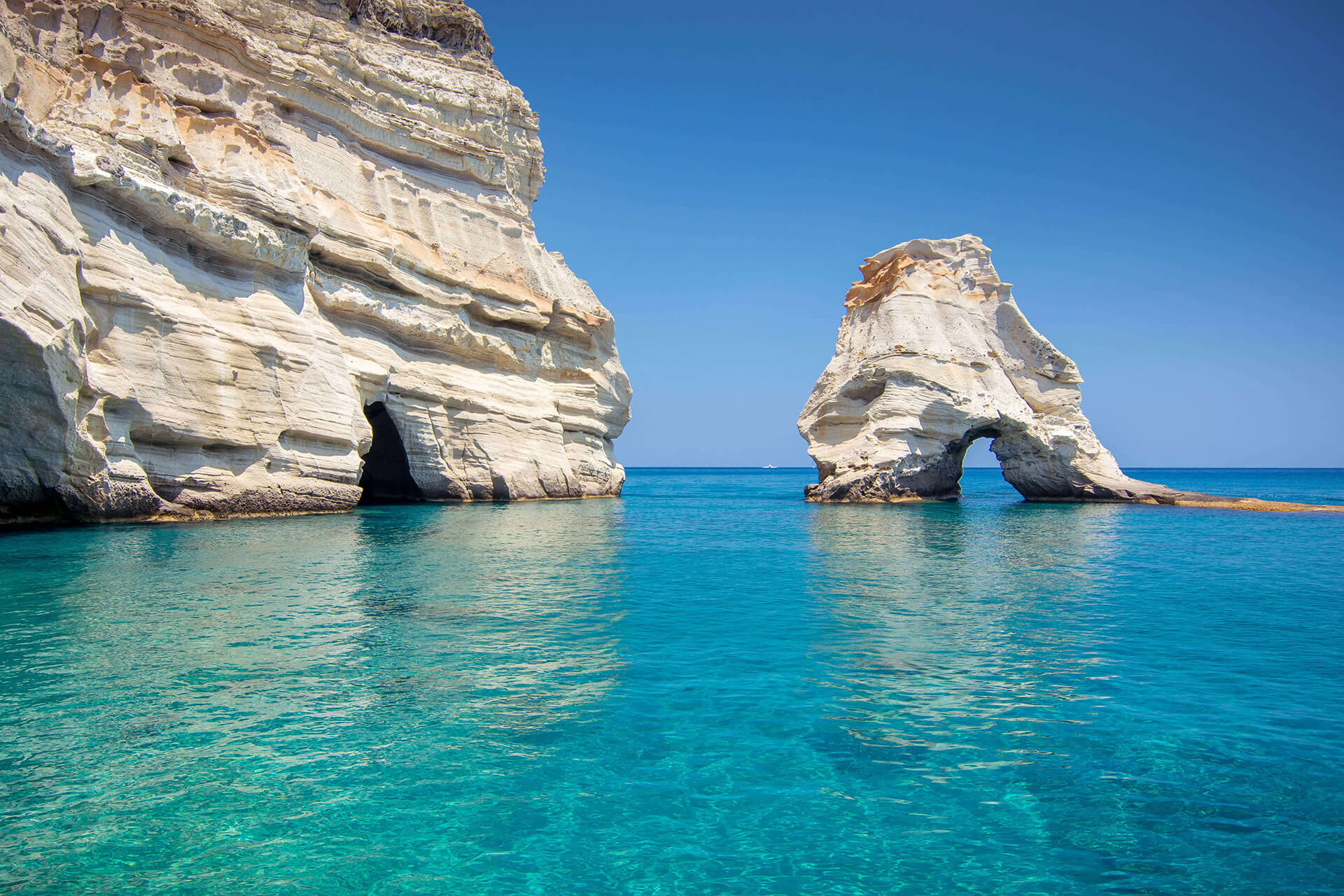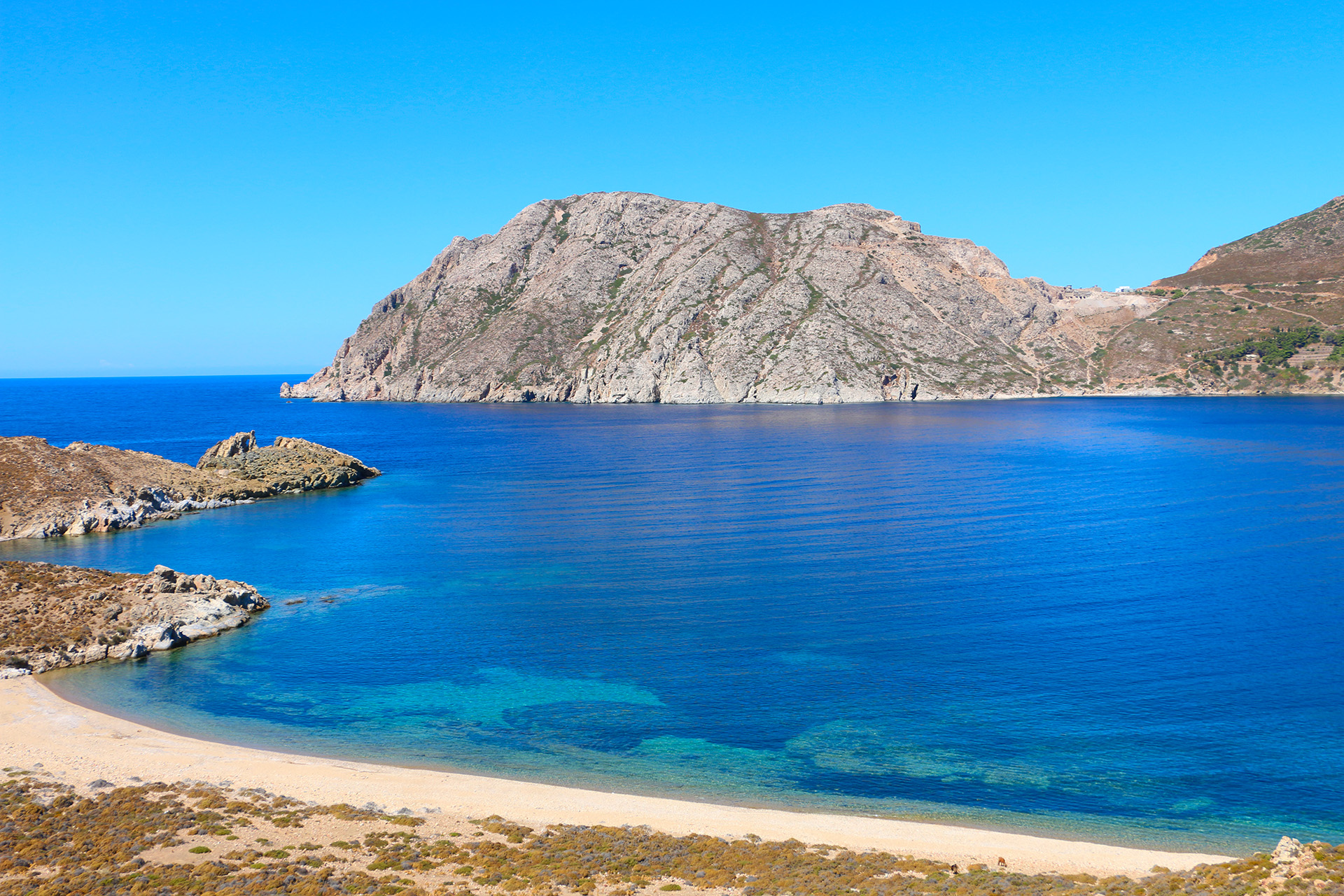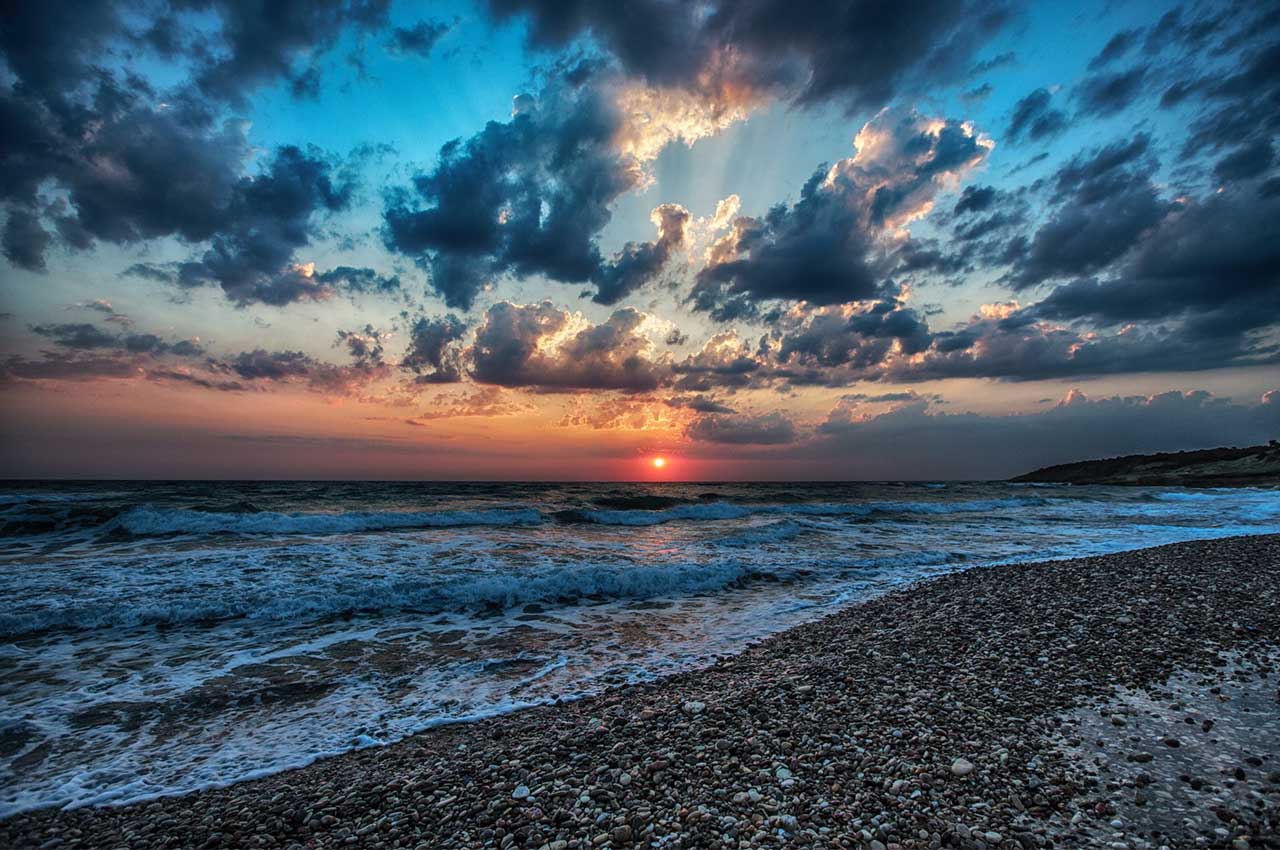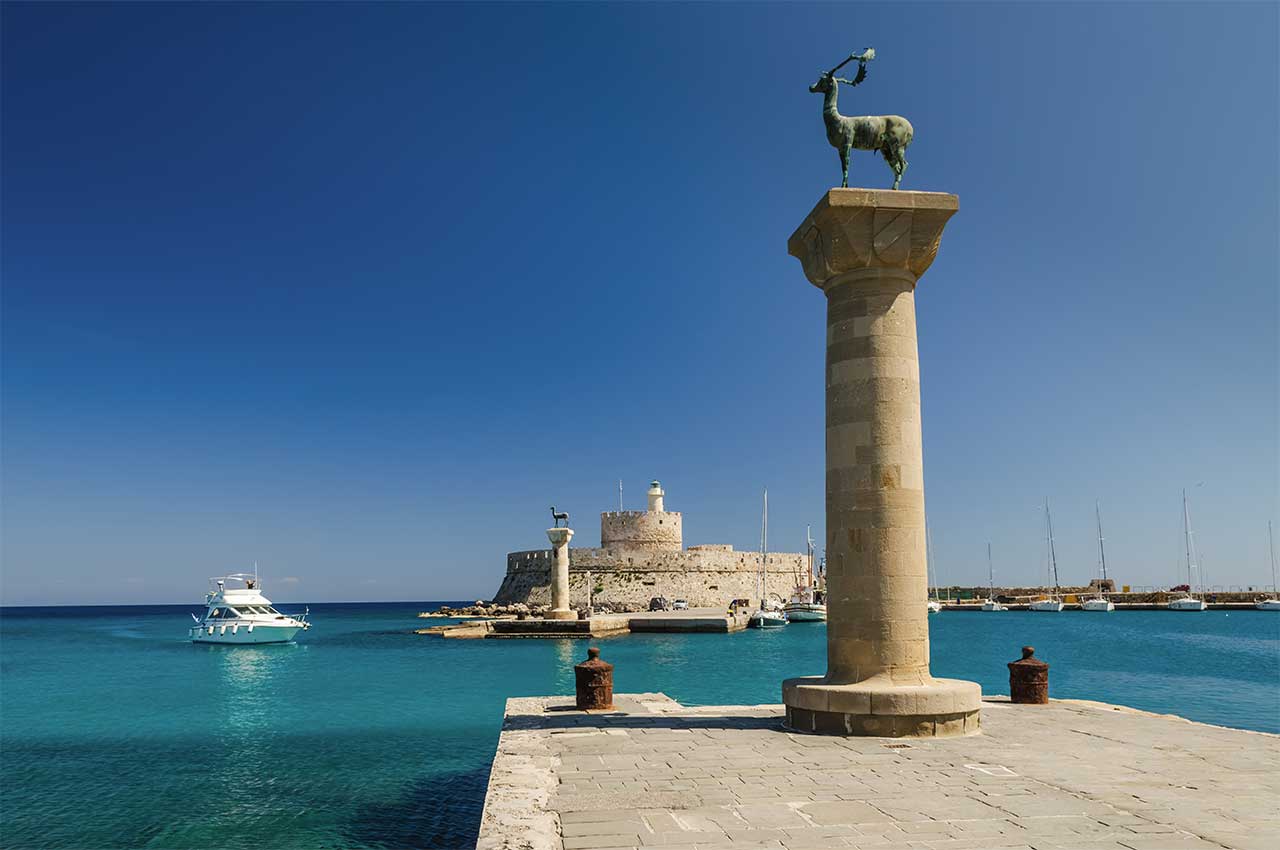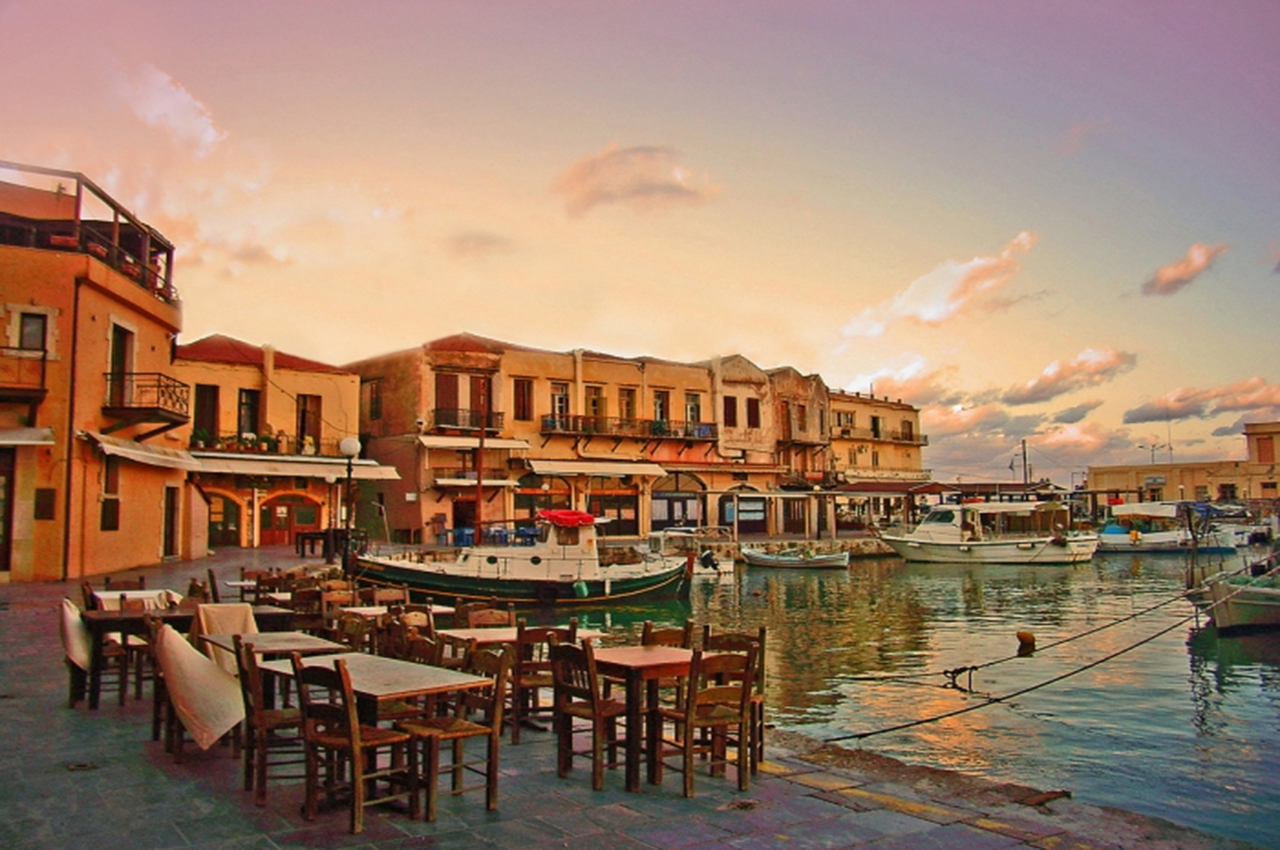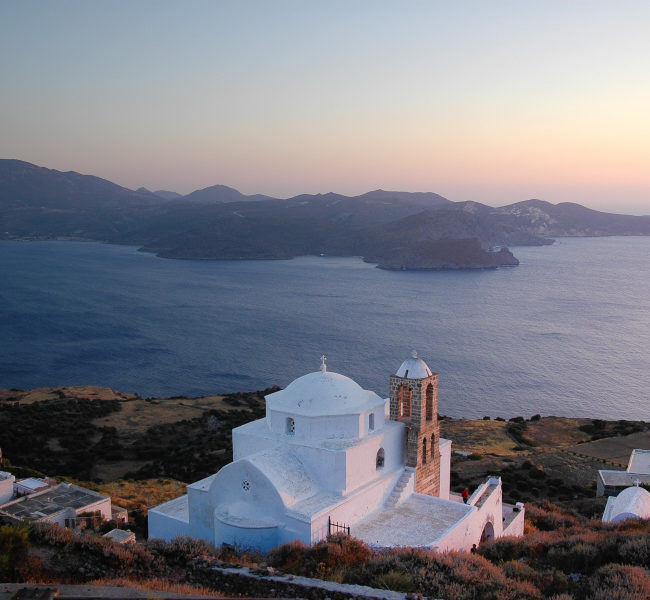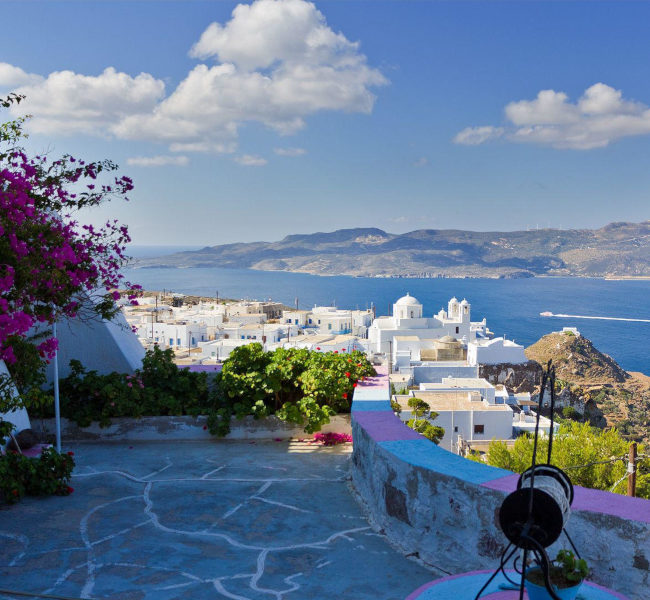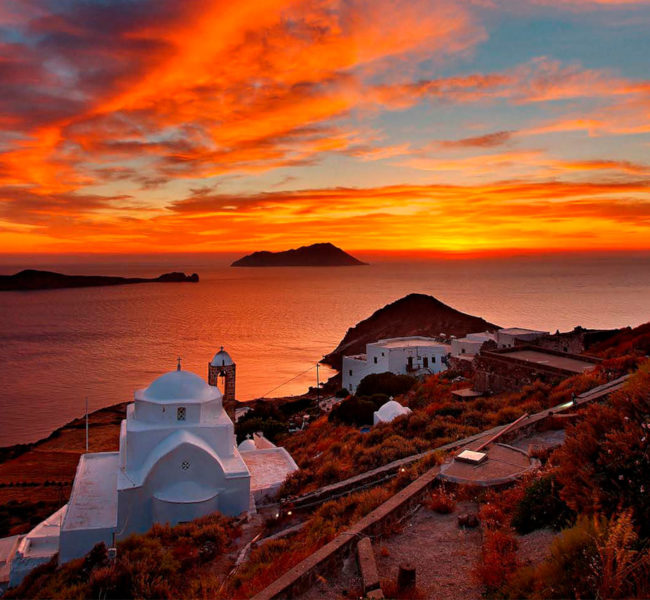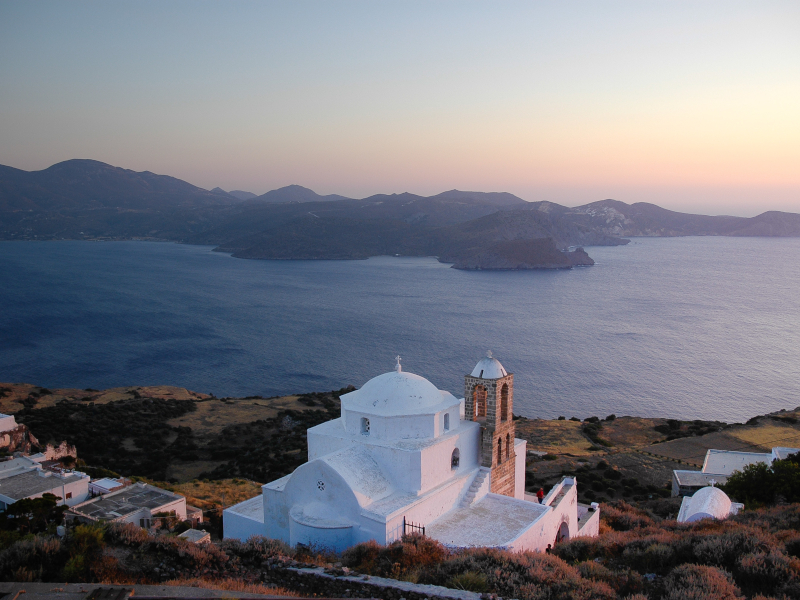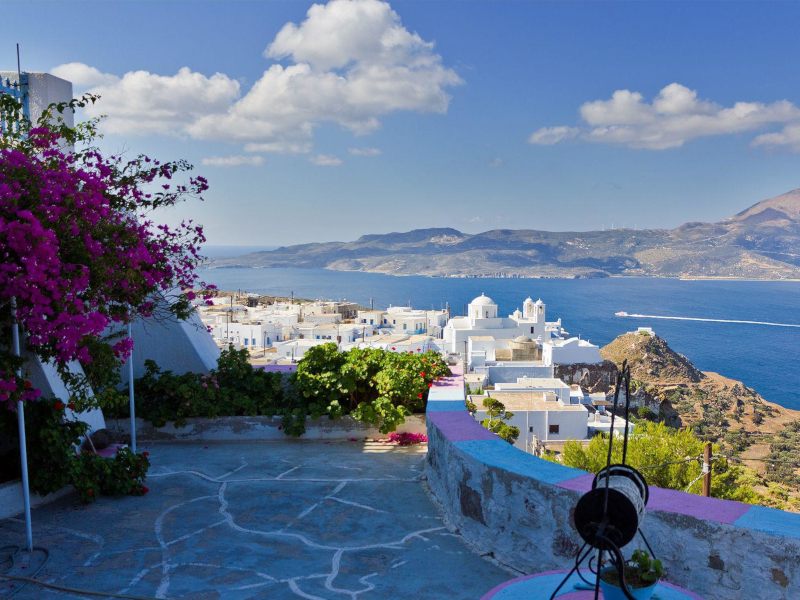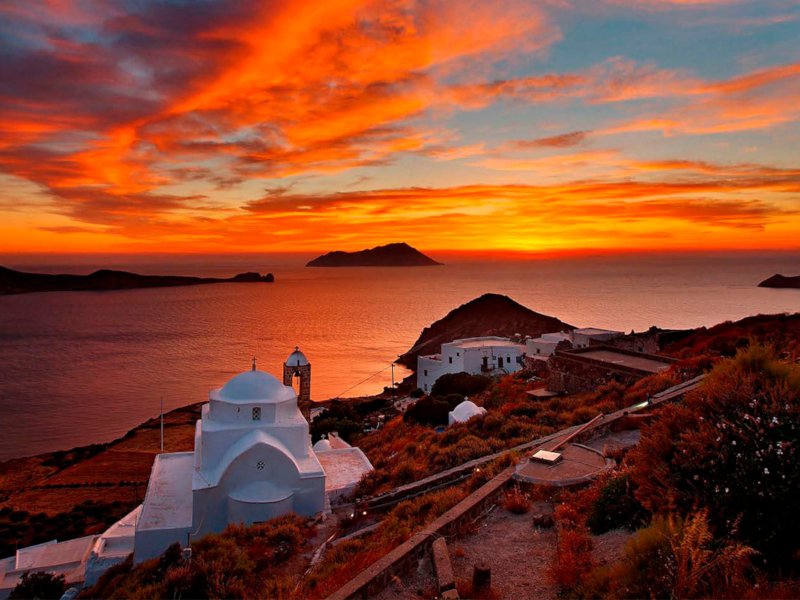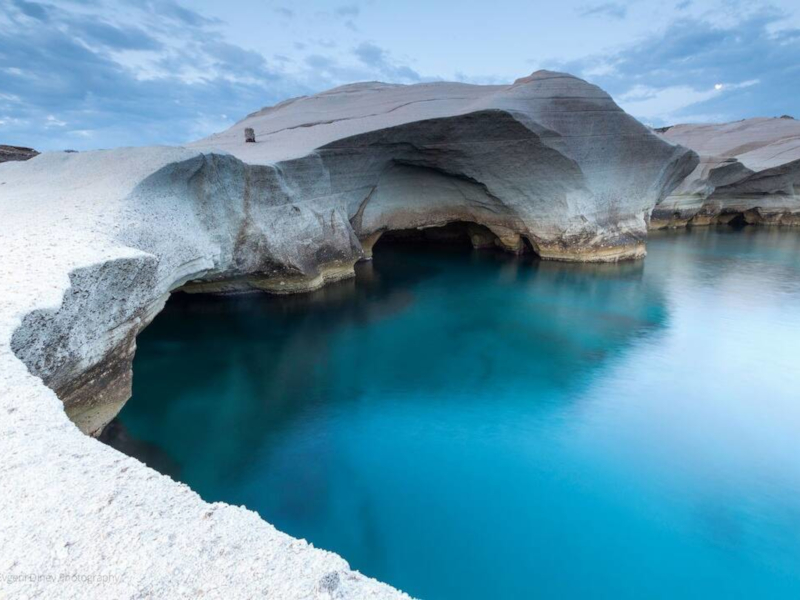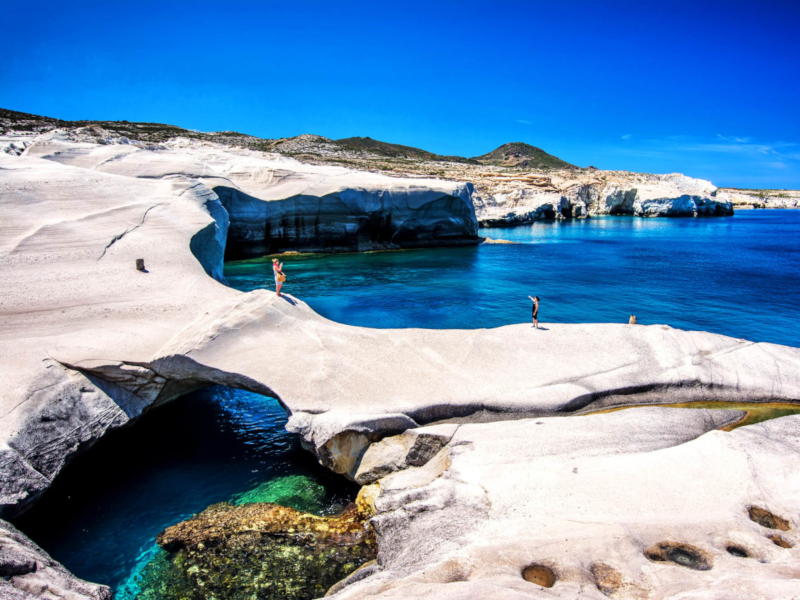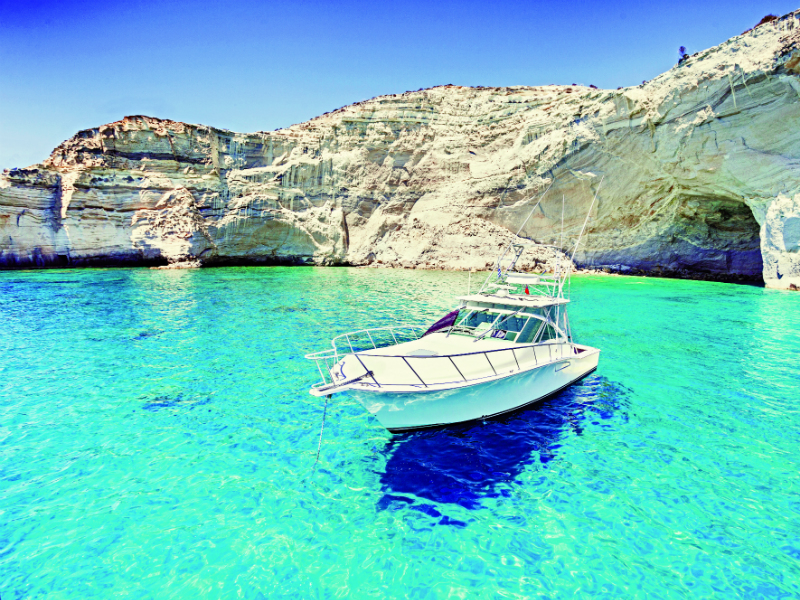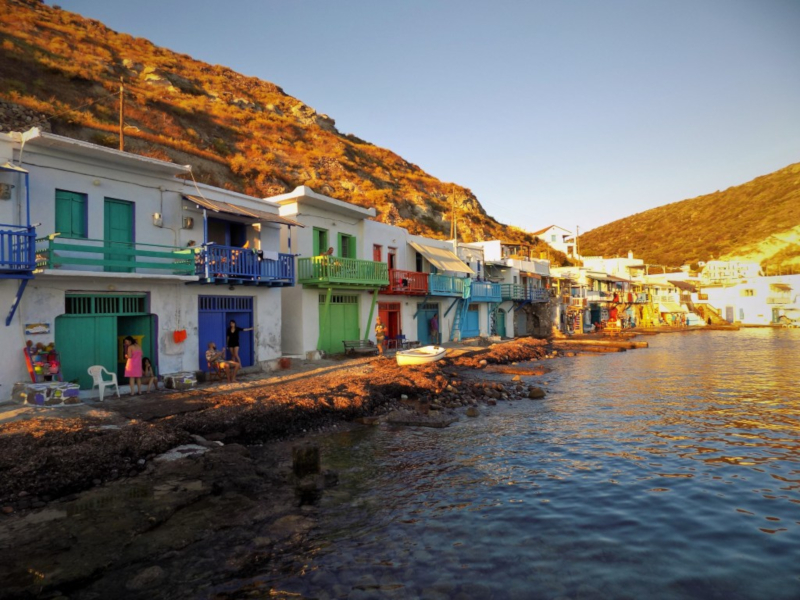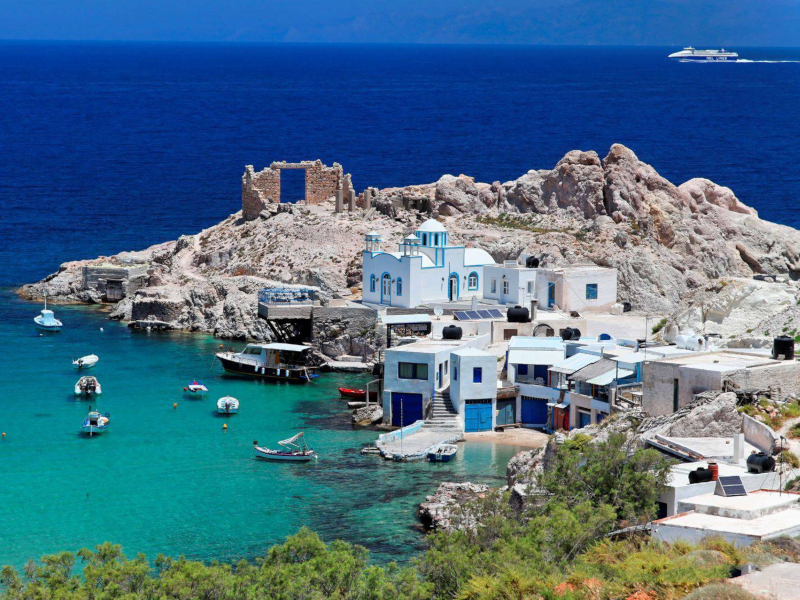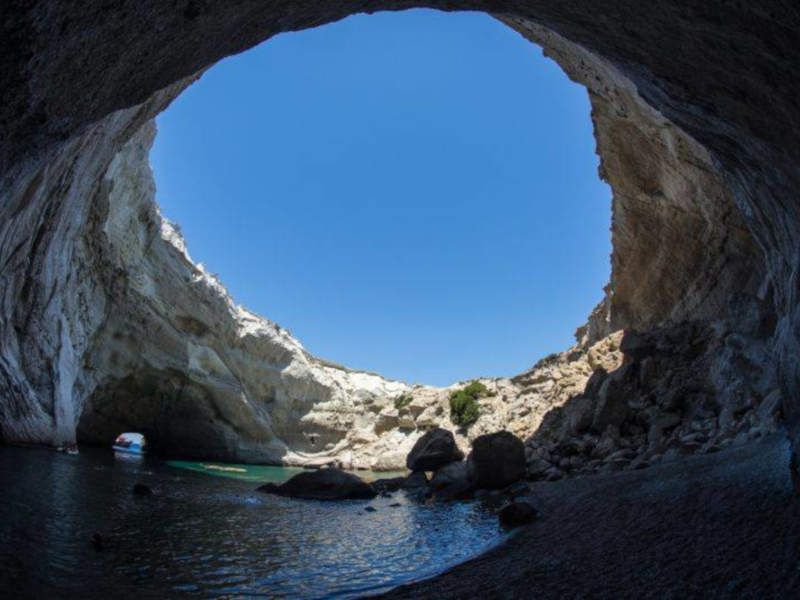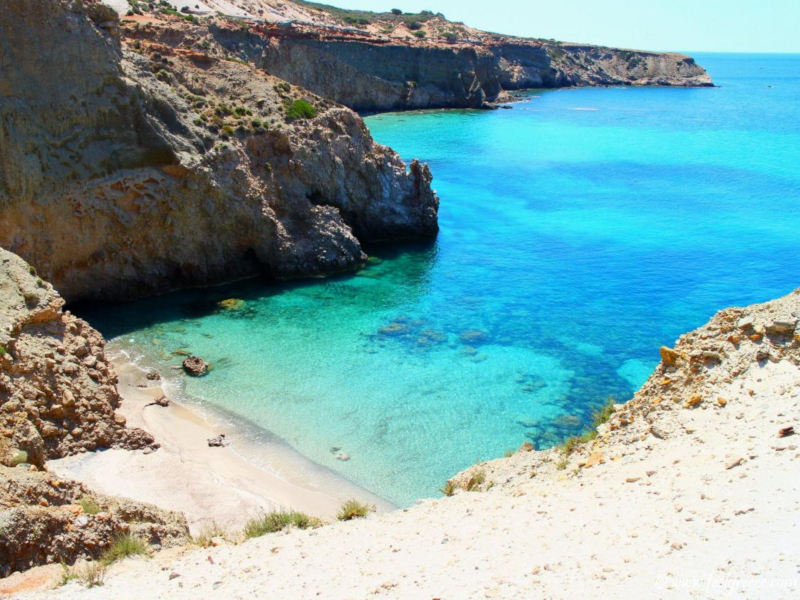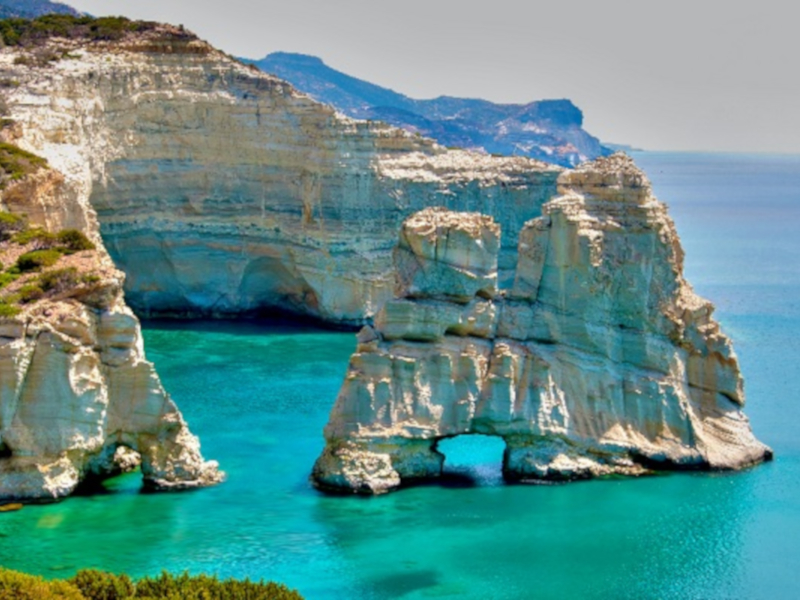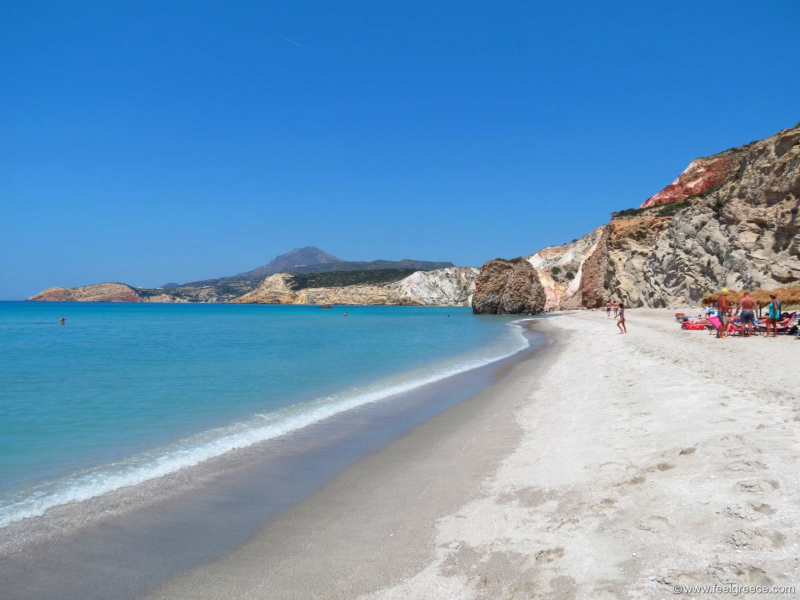Milos
Milos is a volcanic Greek island in the Aegean Sea, north of the Cretan Sea.
It is a wonderful island for holidays, with amazing beaches and impressive monuments.
It is the fifth largest island of the Cyclades, petal-shaped and looks like a theme park with its famous beaches, each one different from the other and beautiful colors due to the volcanic terrain.
Most people in the world know one of Milos’s masterpieces, the famed statue of Venus of Milos, which, even not located on the island (located in the Louvre Museum), has made Milos world-famous.
Milos Island Sightseeing
The Castle
The Castle was built in the 13th century on the hill of Prophitis Ilias, on the northwest edge of the island (today’s Plaka).
It is not inhabited today, but visitors will admire the view of the island’s bay and the magnificent sunset. This Venetian castle was not surrounded by walls, like most castles of the Cyclades, but was protected by the houses themselves. Practically the castle served to protect the locals from pirate attacks (a frequent occurrence of the season), as well as to control the movement of ships in the Gulf of Adamas.
On its top, the “Mesa Kastro”, the Tower of the Governor was located, the so called Palace and around the tower there were a few houses.
Early Christian Catacombs
Here you will see the unique catacombs that are preserved in Greece. An archaeological place from the 1st to the 5th century AD century. They are located near the village of Tripiti, in caves 150 meters above sea level.
In 2009 the Holy Synod declared Milos as a sacred island, since Catacombs are the oldest monument of Christianity. It was the first gathering place for the first Christians and the first community cemetery in second A.D. century.
One of the most important sights of the island.
Klima Village
Klima is the most picturesque fishing village of Milos and is really worth-seeing. This very beautiful village is situated near Tripiti, on the side of the Gulf of Milos.
“Syrmata” are the typical fisherman’s houses, where they stored the boats at the bottom of the house to protect them from the bad weather. The boatmen stayed with their families from above. All houses have bright coloured wooden doors. The sunset here is an amazing experience.
Prehistoric Settlement of Fylakopi
The ancient city of Fylakopi is one of the most important settlements of Cycladic civilization and the most important city of prehistoric Aegean.
Today most of the city is below the sea level, but it’s worth visiting to admire the sanctuary as well as the mansion of the settlement, preserved by the imposing Cyclopean wall of the settlement.
Milos Museums & Churches
Museums
Archaeological Museum of Milos
The Archaeological Museum of Milos is situated in Plaka, it is housed in a beautiful, neoclassic building by Ernst Ziller and features specimens from throughout Milos’ collections.
At the entrance of this building, there is a replica of the famous Venus de Milo. The Venus De Milo statue was originally found in Milos by a farmer in 1870. The real Venus de Milo is in the Louvre Museum in Paris, France.
At the museum the following wonderful collections are exhibited:
A prehistoric collection from Fylakopi
A collection of sculptures and bas-reliefs
An obsidian collection
A collection of inscriptions
Naval Museum of Milos
The small naval museum of Milos has been located in Adamas in the old community building since September 2008. The museum has been working to bring together the maritime history of Milos. The exhibits date back to prehistoric times, with obsidian tools, navigating Salamis and ending in modern times.
At the Museum you will also have the opportunity to see rare maps, from the hands of expert cartographers, and the famous wooden boat “Eirini”.
Ecclesiastical Museum in Milos
The Ecclesiastical Museum of Milos is housed in the church of the Holy Trinity, near the waterfront of Adamas village. This museum is small but it includes many and valuable ecclesiastical items.
The church of the Holy Trinity was built in the 17th century in a very rare architectural form. Through ages, it has been under many renovations. In the yard of this lovely church, you can see a mosaic relief which impressive Bible scenes.
Mineral Museum
The museum is located in the town of Adamas, near the main harbor. Was established to help promote the effects of the mine on the history of Milos and to display the mineral wealth of Milos. This museum was financed by S &B Industrial Minerals S.A.
In the ground floor there are representations, instruments and tools for mining activities on the island for the last 150 years. The old techniques and modern mining activity are presented.
The underground area hosts a variety of museum activities such as educational programs, lectures, presentations, photography exhibitions, film and multimedia displays. The museum also organizes organized geological walks.
Folklore Museum of Milos
The History and Folklore Museum of Milos is housed in a 200-year-old house located at the courtyard of the church of Panagia Korfiatissa, on a hill in Plaka. This small museum has few rooms but interesting exhibits that depict daily life on Milos island from the 17th century till a few decades ago.
The museum consists of the living room, the workplace where the loom is located, the kitchen of the house, the bedroom, the cellar.
In every room you can admire furniture, textiles, embroidery, home decor and everyday items.
Churches
Some of the most famous churches in Milos are:
Assumption of the Virgin or Saint Charalambos
It is located behind the port of Adamas, at the highest point of the village. It was built by Cretan refugees in 1870 and was named after the Church of the Assumption of the Virgin Mary (the old metropolis of the island) and church next to it, Agios Charalambos.
In the courtyard of the church there is also a pebble mosaic of the island created by Ioannis Kavroudakis.
Panagia Korfiatissa
is located on a breathtaking site in Plaka, overlooking at the deep blue sea and the neighbouring islands. The church was built in 1820 with building materials brought from the abandoned churches of the old main town and it is dedicated to the Virgin Mary.
The location is known as “Halara”, and the space in front of the church is known as “Marmara”, due to the fact that the churchyard is paved with marble tombstones from the old city.
Visiting the church, apart from the wonderful view of the sea and the spectacular sunset, you can see relics from the island’s old deserted churches, Cretan-Byzantine icons from the churches of Zefyria, holy relics kept in small silver boxes, the woodcut gold-plated icon screen, as well as the gold-plated epitaph dated from 1600 from the church of Panaghia Skiniotissa, which was brought from Smyrna.
Church of Panagia ton Rodon
In the north side of the church of Panagia Korfiatissa you will find the second Catholic church of the island: the church of Panagia ton Rodon or Rozaria.
This small Catholic church was built by French consul Louis Brest in 1823, with Brest itself buried inside and its wife buried in the courtyard.
Agios Spyridonas Church
The church of Agios Spyridonas is the central church of the village Triovasalos and it is united with the church of Agia Marina. The church has a unique architecture with four large arches. In it you will find pictures of the ruined churches of the old city of Zefyria, as well as the “King of Kings” icon of the famous Cretan hagiographer Skordilis.
If you visit the church of Saint Spyridonas or the church of Saint George on Easter Sunday, you can watch the ‘’burning of Judas”, a custom dated from the early Christian times and which is revived until the present day. This custom is combined also with the custom of “baroutiou-gun powder” as the young people of the two villages, of Triovasalos and Pera Triovasalos, throw dynamites in a space between the two churches, each one contesting for the title of the winner. The winner is the village that will make most of the noise and that will blow up most of the dynamite.
Milos Traditional Products
Milos has many traditional products. Don’t forget to try:
Spoon sweets and sweet watermelon, or fragrant karpouzopita traditional sweet pie with watermelon, and sweet candy of crumb sweet gourd with honey and almonds. Sweet candy serves on the weddings and engagements from the mother of the bride. Honey symbolizes a sweet life for the couple, while almonds fertility.
The pies are these flavors of the tradition of the island must try the pies, stuffed xerotyri or cheese with mint, sweet and savory homemade flavors.Here you will find products of local sausages, local cheeses, like xerotyri the xinomyzithra and touloumotyri, prepared with great care in the traditional way, honey, delicious tomato paste production,produces exquisite wines, figs, delicious melons, pumpkins and watermelons.
Milos Folklore Festivals and Cultural Events
Religious Feasts & Festivals
At the festivals of Milos you have the opportunity to taste traditional food and local wine as well as to dance and have fun under the sounds of traditional island music.
Festivals are organized in temples and chapels often during the summer and specifically the following dates
June
Holy Spirit (50 days after Easter) in Holy Triniti, Adamas
July
1 July in Aghious Anargyrous
6 July in Aghia Kyriaki
17 July in Aghia Marina, in Adamantas
19 July in Profiti Hlias, in Chalaka and in Komia
21 July in Aghia Markela, in Kipos
25 July in Aghia Paraskeui, in Pollonia
26 July in Aghios Panteleimonas, in Plakota and Korfo
27 July in Aghios Panteleimonas, in Emporiou
August
14 August Assumption of Virgin Mary, in Zefiria
15 August Aghios Charalambos in Adamantas
17 August Aghios Floros, in Komia
22 August Mary the “Curing”, in Komia
22 August Mary of Kipos
22 August Reveled Mary, in Tripiti
26 August Aghios Fanourios, in Pollonia
28 August Aghios Ioannis, in Agrilies and Provatas
29 August Aghios Alexandros, in Katsouli
31 August Pantokratora, in Mytakas and Bonfires of August in Tripiti’s square.
September
6 September Aghios Sostis, in Provatas
7 September Mary Mercyfull, in Psathadika
8 September Mary of Hilltop, in Plaka
13 September Holy Cross, in Kaneria
17 September Aghia Sofia, in Halakas
16 September three day celebration in Aghios Ioannis, in Halakas
Cultural Events
Milos Festival
The Festival of Milos is the most important cultural event on this island which is held on the first weekend of July. It usually lasts for one or two months and the set of events includes concerts, art exhibitions, dance happenings, children activities, book fairs, and film festivals.
Milos Beaches
Beaches in Milos distinguish for their unique natural beauty and gorgeous water.
The magnificent colors and the interesting rock formations of Milos beaches provide great places to spend a day at the sea. Some of these are:
Sarakiniko Beach
It is located along the coastal road east of Adamas, north-east of Milos. Sarakiniko beach is the most famous beach of the island, thanks to its unique lunar landscape. Whole volcanic rock formations with exquisite deep blue waters. There is also a small natural harbor, closed between the rocks, with sand and green-blue waters. This amazing scenery gives one the impression of standing on the surface of the moon.
Achivadolimni Beach
It is the biggest beach of the island with a snow-white coast and navy blue shallow waters.
There, you will find an organized camping and the beach is accessible by bus, too. It was named after the lake that exists in the opposite side which is full of clams.
The beach is divided into two beaches: the first is more quiet and isolated, whereas the second is more frequent, organized and there are a beach-bar and restaurants.
The beach is the ideal choice for the lovers of surfing and kite-surfing.
Kleftiko Beach
Kleftiko or “Sea Meteora” as many call it, constitutes a group of grey-white rocks of strange shapes and formations, with caves and cavities created by the wind and the sea in the passing of the centuries.
According to popular tradition, pirates who used the area as a hideout .have hidden treasure in the area and and it was named after them . Kleftiko is an impressive spot of rock formations that can be reached only by sea. In fact, many excursion boats make the tour of the island and pass by Kleftiko .
Tsigrado
Beach embraced by immense rocks, with white sand and emerald waters. Access to this truly exotic beach and visitors have to pass through a rocky passage to get there. The surrounding environment with the rocky cliffs is quite impressive. The beach is not organized, but you can get everything you need from the nearby Firiplaka beach.
Papafragas Beach
Next to the ruins of the ancient city of Fylakopi, the three caves of Papafragas are located.
The cavern of Papafragas is a deep sea cave, where you can swim in green-blue waters between white-grey rocks leading to the open sea. The beach is small in size, surrounded by the gigantic, light-colored rocks and in order to get there you will have to go down a steep carving on the rock. In Byzantine times, it was used as a hide-out for pirates and it was named after the last Frank Pope.
Fyriplaka Beach
Impressive volcanic beach with imposing volcanic rocks, white – grey sandy beach and white pebbles. It features shallow turquoise waters, a beach bar and sun loungers with umbrellas. Firiplaka also enables those who want to avoid the crowds to enjoy its splendor and beauty on the two most lonely beaches (next to the first one organized), provided they stroll along the sea and the volcanic rocks.
-
Destination
Tour Location


